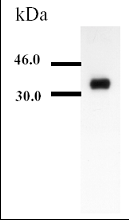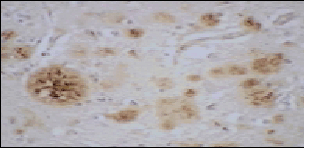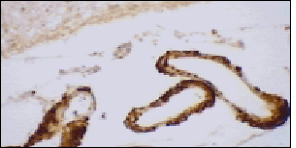生物来源
mouse
质量水平
抗体形式
culture supernatant
抗体产品类型
primary antibodies
克隆
E6D7, monoclonal
表单
liquid
不包含
preservative
种属反应性
human
请勿与下列物质发生反应
mouse, rabbit
制造商/商品名称
Calbiochem®
储存条件
OK to freeze
avoid repeated freeze/thaw cycles
dilution
(ELISA
Immunoblotting (1:100-1:1000)
Immunoprecipitation
Frozen Sections (1:100-1:10,000)
Paraffin Sections (1:100-1:10,000, formic acid or heat pre-treatment required))
同位素/亚型
IgG1
运输
wet ice
储存温度
−20°C
靶向翻译后修饰
unmodified
基因信息
human ... APOE(348)
一般描述
Anti-Apolipoprotein E, mouse monoclonal, clone E6D7, recognizes the ~35 kDa Apo E2, E3, and E4 in human serum and brain. It is validated for ELISA, WB, IP, and paraffin and frozen sections.
Mouse monoclonal antibody supplied as diluted culture supernatant. Recognizes the ~35 kDa E2, E3, and E4 isoforms of apolipoprotein E.
Recognizes the ~35 kDa E2, E3, and E4 isoforms of apolipoprotein E in human serum and brain.
免疫原
Human
a synthetic peptide corresponding to amino acids surrounding the polymorphic amino acid position 158 of ApoE
应用



ELISA (see comments)
Immunoblotting (1:100-1:1000)
Immunoprecipitation (see comments)
Frozen Sections (1:100-1:10,000)
Paraffin Sections (1:100-1:10,000, formic acid or heat pre-treatment required)
包装
Please refer to vial label for lot-specific concentration.
外形
Culture supernatant diluted in PBS.
制备说明
Following initial thaw, aliquot and freeze (-20°C).
分析说明
Positive Control
Brain tissue, serum
Brain tissue, serum
其他说明
Golabek, A.A., et al. 1996. J. Biol. Chem.271, 10602.
Recognizes the ~35 kDa E2, E3, and E4 isoforms of apolipoprotein E in human serum, but multiple bands are seen when used with brain tissue samples. Staining of formalin-fixed paraffin-embedded tissues may be enhanced by the pre-treatment of tissue with 70% formic acid for 10-30 min at room temperature or by heat pre-treatment using citrate buffer, pH 6.0. This antibody has also been reported to work for immunoprecipitation and ELISA. Antibody should be titrated for optimal results in individual systems.
法律信息
CALBIOCHEM is a registered trademark of Merck KGaA, Darmstadt, Germany
免责声明
Toxicity: Standard Handling (A)
未找到合适的产品?
试试我们的产品选型工具.
储存分类代码
11 - Combustible Solids
WGK
WGK 1
闪点(°F)
Not applicable
闪点(°C)
Not applicable
Abraham Kuot et al.
Clinical & experimental ophthalmology, 47(8), 1028-1042 (2019-06-18)
Fuchs endothelial corneal dystrophy (FECD) is a progressive and potentially a sight threatening disease, and a common indication for corneal grafting in the elderly. Aberrant thickening of Descemet's membrane, formation of microscopic excrescences (guttae) and gradual loss of corneal endothelial
Dale J Christensen et al.
Journal of immunology (Baltimore, Md. : 1950), 186(4), 2535-2542 (2011-02-04)
The molecular mechanism by which apolipoprotein E (apoE) suppresses inflammatory cytokine and NO production is unknown. Using an affinity purification approach, we found that peptide mimetics of apoE, derived from its receptor binding domain residues 130-150, bound to the SET
Veena Theendakara et al.
The Journal of neuroscience : the official journal of the Society for Neuroscience, 36(3), 685-700 (2016-01-23)
A major unanswered question in biology and medicine is the mechanism by which the product of the apolipoprotein E ε4 allele, the lipid-binding protein apolipoprotein E4 (ApoE4), plays a pivotal role in processes as disparate as Alzheimer's disease (AD; in
Jing Zhang et al.
FASEB journal : official publication of the Federation of American Societies for Experimental Biology, 33(6), 7748-7757 (2019-03-22)
Aging and apolipoprotein E4 (ApoE4) can increase the risk of cognitive impairment and neurodegenerative disorders, including Alzheimer's disease (AD), and patients with type 2 diabetes mellitus are highly susceptible to cognitive dysfunction. Recent research has indicated that metformin, a prescribed
Xia Hu et al.
Frontiers in neuroanatomy, 11, 45-45 (2017-06-24)
Genetic variations in the vacuolar protein sorting 10 protein (Vps10p) family have been linked to Alzheimer's disease (AD). Here we demonstrate deposition of fragments from the Vps10p member sortilin at senile plaques (SPs) in aged and AD human cerebrum. Sortilin
我们的科学家团队拥有各种研究领域经验,包括生命科学、材料科学、化学合成、色谱、分析及许多其他领域.
联系客户支持